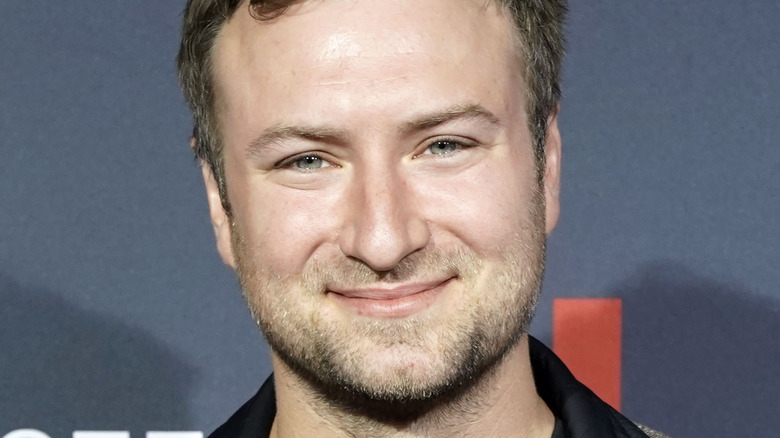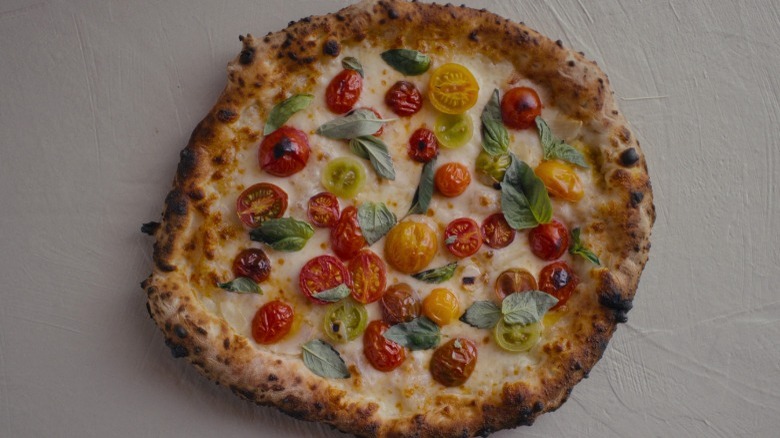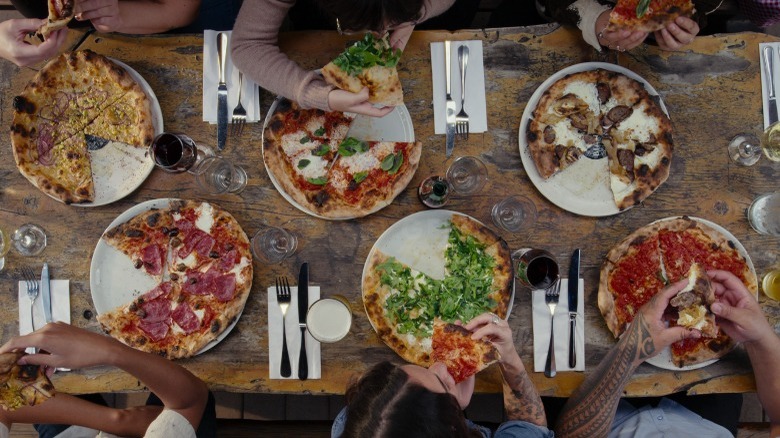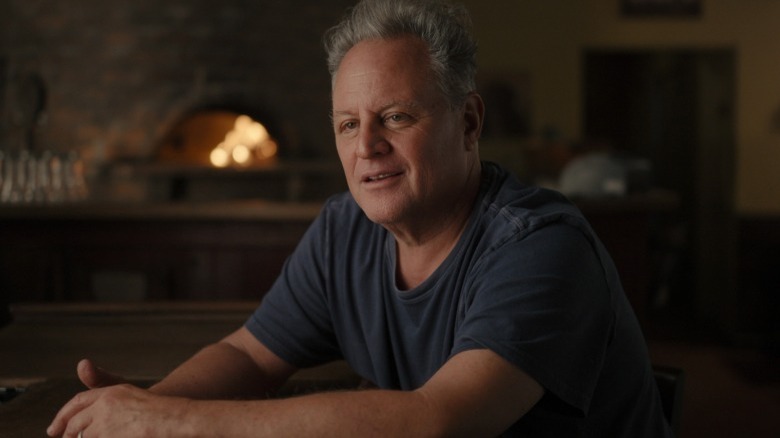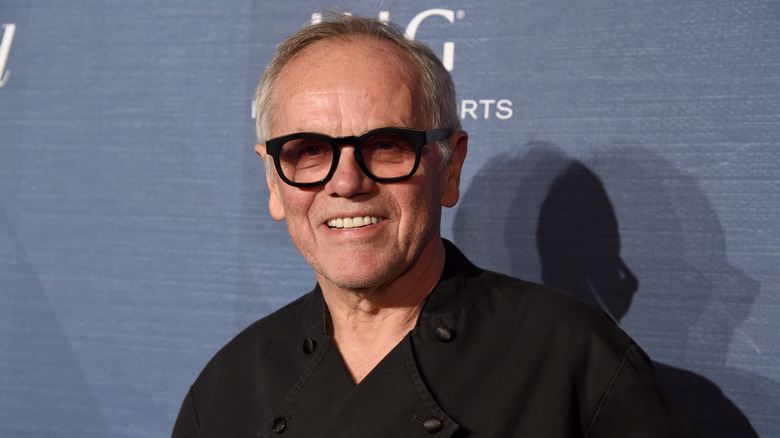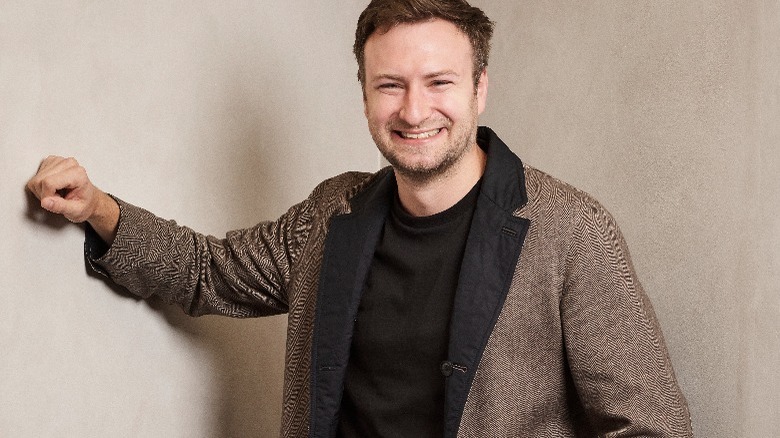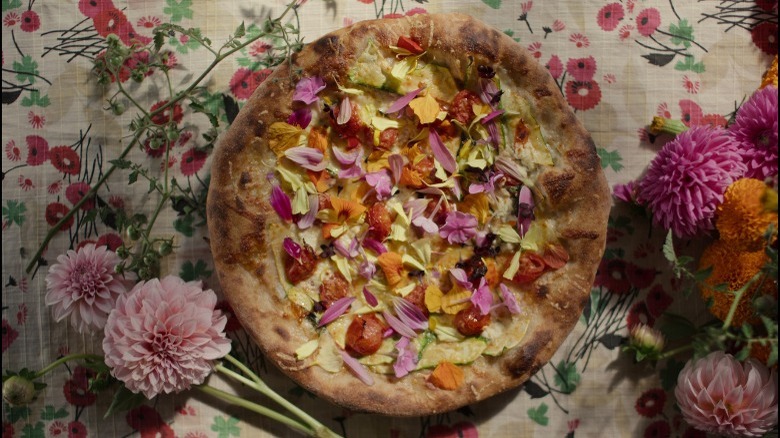David Gelb Gives An Inside Look At Chef's Table: Pizza - Exclusive Interview
Between the stunning cinematography and touching stories, "Chef's Table" has risen to fame as one of the most popular cooking shows in history. This beloved docuseries was created by renowned director David Gelb. After directing "Jiro Dreams of Sushi" in 2011, Gelb went on to co-found his production company, Supper Club. Since then, David Gelb has made several seasons of "Chef's Table," an in-depth documentary on Wolfgang Puck, and has even signed a multi-year production agreement with Disney+.
That said, Gelb's latest "Chef's Table" venture might be the tastiest one yet. There is no denying that pizza is one of the most universally loved foods in the world. While it may seem like a simple combination of dough, cheese, and tomato sauce, "Chef's Table: Pizza" shows just how diverse and unique pizza can be. Of course, in true "Chef's Table" fashion, the stories behind these pizza masters are both heartwarming and tear-jerking, resulting in an immersive and enticing series that you won't want to miss. Gelb sat down with Tasting Table to discuss his favorite pizza style, his upcoming projects, and the ins and outs of what went into the making of "Chef's Table: Pizza."
The process behind Chef's Table: Pizza
How long has "Chef's Table: Pizza" been in the works?
"Chef's Table: Pizza" is something that we had planned to do before the pandemic, but we ended up shooting through it. It's something that we've been talking about and preparing for three or four years now. We started shooting it probably toward the end of 2020.
What inspired you to choose pizza as the next topic for "Chef's Table"?
We really enjoyed doing "Chef's Table: Barbecue," and we also enjoyed doing "Pastry." We liked the idea of these specialized seasons, and the barbecue season was really popular. We thought maybe it's the continuation of the journey of our show — to go where we started, with rarefied, very elite, Michelin-Star dining to more popular foods — to do one about pizza, which, as far as I can tell, is the most popular food in the world.
We thought it'd be interesting to tell the stories of chefs [who] use pizza — which on its surface is generally considered to be just tomato sauce, dough, and cheese — as a canvas to express themselves. [We wanted to] find a way to tell stories about pizza chefs that can approach pizza in these very different ways, and the stories that took them there.
How many pizza places did you research and try before deciding which chefs to feature?
Many. My partner on the show, Brian [McGinn], is an absolute pizza nut. He's been traveling and eating pizza everywhere in the world since we started the show, so this was something that he was very, very excited about. There are a lot of factors that go into the final selections, including the timing. There's also travel restrictions and pandemic issues, which is why half of the episodes are in the United States, but we have fantastic pizza chefs, so I don't think there's any compromise there.
But there are many factors that go into the reason that we choose the chefs that we do. That said, it's countless, the number of pizza chefs that have great stories out there that we could have done, but we only got to do six.
Is there any particular style of pizza that you tried during the research or filming process that you feel is underrated or should be more popular?
One thing that's interesting is Pepe Franco's fried pizza ... I haven't seen that in the United States. It may be here, but that's something that's interesting and that may spread.
During Ann Kim's episode, she says something that's so smart, which is that pizza is a vehicle that allows people to try things that they may not have tried. She has a pizza that has kimchi on it. Many of her guests have never had kimchi before, but she's like, "If you put it on a pizza, then people trust it." That's really interesting. Maybe there'd be new types of pizza that people watching these shows might want to try [as] something different or something new. You're not going to find kimchi pizzas very often, so maybe we'll be able to open up people's pizza palate to try new things.
David Gelb's pizza preferences
What pizza toppings were you most surprised to be introduced to during filming?
I was blown away by a lot and about how good the pizzas are. I'm not easily surprised because I've been in this food game for a very long time now, so I wouldn't say that I was totally surprised, but I am amazed at how delicious pizza can be. When I went to Pepe in Grani or when I eat at Pizzeria Bianco, [it's] the simple things like the dough being perfect, how good it can be, and how different they can be from each other, even though it's all pizza.
Do you have a personal favorite pizza style?
I grew up in New York City, so I love a cheese pie. In our show "Street Food," we did do a New York slice shop. I like the simple execution of a margherita. That's one of my favorite things. Going back to Pepe Franco, I love the famous pizza where it has those red lines. It's a new presentation of what is classic pizza. My go-to, whenever I go to a pizza place, I always get the margherita or the simple tomato pie as a baseline. Then I like to also get the more experimental stuff.
Were there any specific tricks that you learned when it comes to making the perfect pizza at home?
I don't even attempt it at home, because it's this mastery of a simple thing. Brian [McGinn] is a lot braver and puts himself out there. He's got his pizza oven and he's got his starters, and often, he actually makes the real pizza dough. When we were in prep for this, in fact, he even drove around and gave everyone some dough and we did a Zoom — the whole "Chef's Table" team — and he was showing us how to do it. This was in peak pandemic moment, which was really sweet.
That said, I have too much respect for the pizza makers out there that are good to ruin it in my own home. The most I'll do is I'll buy some pre-made dough from Italy and do a little pizza party. My son's three and he loves pizza, so we do that. I love how these chefs have mastered this seemingly simple thing. It reminds me of sushi in a way, because I can't make sushi rice like the great sushi chefs. I don't try to make sushi at home, and I don't really try to make pizza at home either. It's the same thing.
The chefs behind Chef's Table: Pizza
Why did you choose Chris Bianco as the featured chef for Episode 1?
For our show, we're always trying to bring in a broader audience; we want to bring in more people to see what chefs do and the passion in their lives. It was an easy choice with Chris. He's such a great storyteller. He's so vulnerable and clear. It was an English-language episode. Chris is also good friends with Jimmy Kimmel, and he's going to be doing some press for the show. We thought, "Chris, we're going to make you number one."
It's a great story. It has life and death stakes. The moment that you put your life — you put your passion — into something, and then you're told, "If you continue to do this, you'll die" ... It's devastating. There's also a big part of Chris that I found very personally connected to his story, where he was so hands-on with everything. When I made "Jiro Dreams of Sushi," I did pretty much every job on the thing. I was helping with every aspect. I had a translator who was my coordinator and sound boom operator assistant, and that was it. It was just me and the editor working on this film, and I did everything.
The transition to "Chef's Table," where I would learn to delegate, work with the team, trust my team members, and be surprised and amazed at the work that they're doing, it feels a bit like Chris' journey, because when he had to stop being the guy making every single pizza and he learned to delegate, it opened up his whole life. It's a powerful message. You can grind, discover what your medium is, what your path is or what your art is — but at a certain point, you have to bring in team members, because nobody can make it alone. You'll burn out. The only way to sustain and keep doing what you're doing is to work with a great team and trust them.
Which chef from the series had the most unique story to you in regards to where they landed as a pizza chef?
Yoshihiro Imai, perhaps. It's tough, because everybody has an interesting journey. Ann Kim wanted to be an actor, for example. Chris Bianco's was pretty straightforward in terms of he knew that he wanted to do this. All of our chefs take an interesting path, but Ann Kim, whose passion was not at all cooking until after she decided to leave her acting career, [has] quite an interesting path. It makes her such a great storyteller. She's so clear and passionate. Even watching the rough cuts, I was tearing up. I found her story to be unique and beautiful, and the way that she tells it is really beautiful.
Working with Wolfgang
What was it like working with Wolfgang Puck when you did his documentary?
It was amazing. Our final phase of shooting was in Austria, right before the pandemic started. Wolfgang Puck [has] been a hero to me for a long time, since I was a kid, maybe 12 or 13 years old. My dad took me to Spago on a trip to California that I was tagging along with him on, and I knew who [Puck] was. I'd seen him on TV, and he comes to every single table, including ours, and introduces himself and makes you feel so special.
Feeling special in a restaurant is something that I think subconsciously drove me to continue loving food, wanting to eat out, and ultimately making "Jiro," "Chef's Table," et cetera. It was an amazing thing to come full circle and quite an honor that he allowed me to make this film about him, because it was the first biographical documentary about this guy who is the most famous chef in the world. He completely put his trust in us. He gave us the final cut on the movie, which is how we work with all of our chefs. They have to trust us and give us their lives. We tell it as faithfully and respectfully as we can.
He has an incredible personality. He's a great cook. He's a great teacher. I look at him as a model for how to build teams and allow them room to grow. I found parallels in what we're doing with what he does. On "Street Food," editing assistants became editors and camera assistants became cinematographers. Everybody had a place to grow and to move up.
That's how Wolfgang does it as well. He'll open a new restaurant and give people a chance to do a bigger role. That's really great. I have so much admiration for him and all that he's contributed to the world of food, the open kitchen, pizza, and for talking about pizza. He's someone who introduced this idea of fancy pizza in America. It goes on and on.
Considering that he is one of the most famous chefs in the world, did you feel a lot of pressure when it came to creating that intimate portrait of his life?
That was something in our early discussions that was a determining factor when we were deciding if we were going to do it. I had a frank conversation. I was like, "We're going to talk about some of the more difficult parts of your life. Are you willing to go there?" He wanted to go there. I felt sure that even though he was so famous, we were showing a new side of him and something that people hadn't seen.
It's something that he wanted to do because he didn't want people to think that he just came from Austria and went straight to the Oscars. He wanted people to know that you can come from a very difficult situation, and through a combination of perseverance, luck, and preparation, be ready to seize the luck when it comes. That's something that he wanted to share. He wanted to also share his story with his kids so they could understand where he came from. I was glad to be the one to be able to talk to him about that and to bring it to bear.
A sneak peak of what's in store for Supper Club
Are there any upcoming projects that Supper Club has in the works that you can give us a sneak peek at?
"Chef's Table: Pizza" comes out on the seventh, and on the eighth, we have a documentary that Supper Club did. I produced. I directed it — [it's] about "Star Wars," specifically Obi-Wan Kenobi. It was something that we made in tandem with their new "Obi-Wan Kenobi" series that came out a few months ago. Originally, it was going to be a behind-the-scenes piece, but the people at Lucasfilm were excited about it and wanted to make it its own release.
It's all about the history of Obi-Wan Kenobi, starting with Sir Alec Guinness and the reteaming of Hayden Christensen and Ewan McGregor, which I thought was really moving. We also got to shoot it on their high-tech volume stage. All the walls and ceiling are LED screens, and they project the actual 3D environment, so you can have these exteriors inside. It's this cutting-edge technology that they use to shoot "The Mandalorian" and all their other "Star Wars" shows. I think we're the first doc to ever use this Lucasfilm/Industrial Light & Magic technology in that way, so that was very cool.
So you're branching out from food a little bit more?
Yeah. That's good. We love and will continue to make a lot of food-related content because we love to eat, but one of the things that really worked about "Jiro Dreams of Sushi" and "Chef's Table" is that even though they're about food, the stories are analogous to any kind of creative field or medium.
The true art of Chef's Table
What are some of your favorite things about turning food into art through the use of film?
We are approaching it as art, and we're helping the audience see it that way because of the context and the emotion that goes behind it. The fancy cinematography and lighting and lensing can only take us so far. While that was quite surprising to see that style in the early seasons of "Chef's Table," now every other food show is using the same types of techniques. What gives us the most satisfaction is selecting great characters with powerful stories and building the context behind the pizza.
I always go back to this moment. This is a breakthrough moment when we were making "Jiro Dreams of Sushi," which was a challenge. Me and my editor, Brandon Driscoll-Luttringer, were very concerned about "How are we going to sustain this thing?" You have the beautiful sushi and you see the craft and how they do it, but then we realize that it's about this context.
The example that I always go back to is Nakazawa-san, who was the assistant that does the egg sushi. You hear the story about the egg sushi being the final test. It's the hardest thing to do, called the Tamagoyaki, and they do it in this special square grill pan. It's a very challenging cook, not only in the mixing and the making of it but the actual execution of the cooking, because it's a perfect square, the pan. The egg sits in there, and you have to somehow maintain the perfect integrity of the shape of the egg, flip this thing over using chopsticks with one hand and the pan in the other hand. It's an incredibly difficult execution, and then you have to settle it back in using those chopsticks.
You see in the film, he drops it a couple of times. There are a couple of failed attempts. The work that goes into that ... He says he did it 200 times before they would let him serve it to the customers. But then when he did, it's such a moment of triumph. When that piece of sushi, later in the film, lands on the bar, as the audience, you get a feeling it's not just about how beautiful it looks. There's an emotional response because of the context and because of the story. That's what sets "Chef's Table" apart. That's what we're going for — that story.
All episodes of "Chef's Table: Pizza" are now available to watch on Netflix.
This interview has been edited for clarity.
